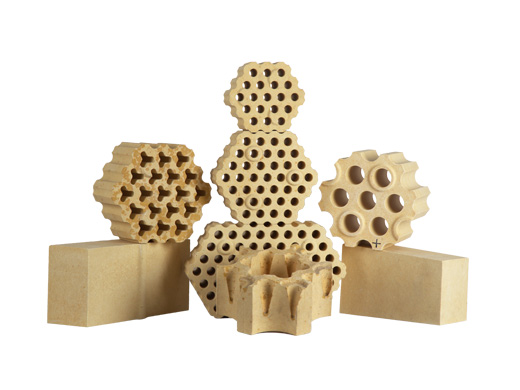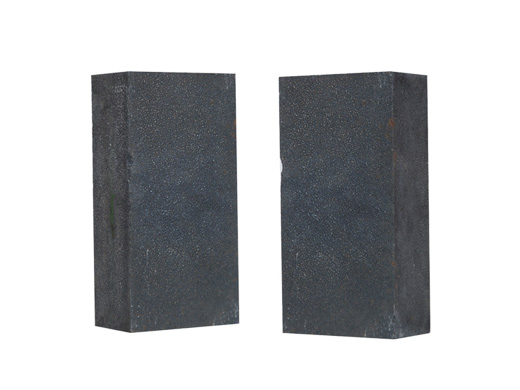Selection and Masonry of Refractory Materials for Glass Furnace
Industry news | Refractory Wiki | Refractory news | Enterprise news | Selection and Masonry of Refractory Materials for Glass Furnace
1. Dense chrome oxide brick
It has the best resistance to high temperature E glass erosion performance, and its corrosives basically do not cause pollution to the molten glass, so it has become the first choice for high-quality refractory bricks for E glass unit kilns.
Dense chromium oxide is formed by isostatic pressing, and its density is very high. The main technical indicators are Cr2O3 content>94%, porosity <15%, volume density>4.24g/cm3, and erosion loss is only 1/10 of that of compact zirconium bricks. . It is used in E glass furnace unit kiln that directly contacts the wall of the melting part of the high temperature molten glass, the bottom of the high temperature part of the melting part, the wall and bottom of the main passage, the wall of the transition passage, etc.
2. Dense Zirconia Brick
The brick’s resistance to high temperature & molten glass erosion is slightly lower than that of compact chromium oxide bricks. It is also formed by isostatic pressing. Its technical indicators are ZrO2>65%, apparent porosity<2.0%, and bulk density about 4.25g/cm3. In E glass, there is corrosion when the temperature exceeds 1370°C. It is used in the bottom of the melting part where the temperature of the molten glass is slightly lower in the E glass unit kiln, the transition channel, the bottom of the forming channel, the flow groove of the forming channel and the slat bracket, etc. In addition, dense zirconia bricks are also used as backing bricks for dense chrome bricks.
Many refractory companies have also successively introduced foreign technology and equipment, and have also produced sintered dense zirconium bricks formed by isostatic pressing, which have been partially used in domestic glass and fiberglass kilns.
3. Standard zirconium brick
The ZrO2 content of the brick is about 66%, the bulk density is 3.7g/cm3, and it has good thermal stability and peeling resistance. It is used in the breast wall and back wall of the feeding port area where powder erosion is more serious, the breast wall of the furnace observation hole brick and the passage flame space, the roof brick and the burner brick. But there are also burner bricks using AZS, mullite bricks as transition bricks and gap bricks on both sides of the kiln.

4. Sintered mullite bricks
The brick chemical composition is Al2O3>74%, SiO2 2.2%. The bulk density is 2.5g/cm3, the main purpose is standard chromium backing bricks, melting part breast wall and front wall bricks, passage flue lining bricks, large chute foot and discharge port outer bricks, heat exchanger entrance flue outer wall bricks Wait. There is also a kind of mullite bricks that are sintered after forming mullite crystals by the melting method; they have better resistance to high temperature creep and thermal shock resistance, and can be used as kiln towers and flame space breast walls. The effect is very good, and the localization has been successful.
5. Fused Zirconia Corundum Brick (AZS Brick)
The brick chemical composition is ZrO2 34%, Al2O3 49.2%, and SiO2 15.9%. The bulk density is 3.85g/cm3, and the main uses are the burner bricks of the melting part and the bricks of the feeding port.
6. Fused chrome corundum brick
The chemical composition of the brick is 28.3% Cr2O3, 58.3% Al2O3, 5.2% MgO and Fe2O3. The bulk density is about 3.4g/cm3. Mainly used in the flue interface bricks at the entrance of the heat exchanger.
1. Dense chrome oxide brick
It has the best resistance to high temperature E glass erosion performance, and its corrosives basically do not cause pollution to the molten glass, so it has become the first choice for high-quality refractory bricks for E glass unit kilns.
Dense chromium oxide is formed by isostatic pressing, and its density is very high. The main technical indicators are Cr2O3 content>94%, porosity <15%, volume density>4.24g/cm3, and erosion loss is only 1/10 of that of compact zirconium bricks. . It is used in E glass furnace unit kiln that directly contacts the wall of the melting part of the high temperature molten glass, the bottom of the high temperature part of the melting part, the wall and bottom of the main passage, the wall of the transition passage, etc.
2. Dense Zirconia Brick
The brick’s resistance to high temperature & molten glass erosion is slightly lower than that of compact chromium oxide bricks. It is also formed by isostatic pressing. Its technical indicators are ZrO2>65%, apparent porosity<2.0%, and bulk density about 4.25g/cm3. In E glass, there is corrosion when the temperature exceeds 1370°C. It is used in the bottom of the melting part where the temperature of the molten glass is slightly lower in the E glass unit kiln, the transition channel, the bottom of the forming channel, the flow groove of the forming channel and the slat bracket, etc. In addition, dense zirconia bricks are also used as backing bricks for dense chrome bricks.
Many refractory companies have also successively introduced foreign technology and equipment, and have also produced sintered dense zirconium bricks formed by isostatic pressing, which have been partially used in domestic glass and fiberglass kilns.
3. Standard zirconium brick
The ZrO2 content of the brick is about 66%, the bulk density is 3.7g/cm3, and it has good thermal stability and peeling resistance. It is used in the breast wall and back wall of the feeding port area where powder erosion is more serious, the breast wall of the furnace observation hole brick and the passage flame space, the roof brick and the burner brick. But there are also burner bricks using AZS, mullite bricks as transition bricks and gap bricks on both sides of the kiln.

4. Sintered mullite bricks
The brick chemical composition is Al2O3>74%, SiO2 2.2%. The bulk density is 2.5g/cm3, the main purpose is standard chromium backing bricks, melting part breast wall and front wall bricks, passage flue lining bricks, large chute foot and discharge port outer bricks, heat exchanger entrance flue outer wall bricks Wait. There is also a kind of mullite bricks that are sintered after forming mullite crystals by the melting method; they have better resistance to high temperature creep and thermal shock resistance, and can be used as kiln towers and flame space breast walls. The effect is very good, and the localization has been successful.
5. Fused Zirconia Corundum Brick (AZS Brick)
The brick chemical composition is ZrO2 34%, Al2O3 49.2%, and SiO2 15.9%. The bulk density is 3.85g/cm3, and the main uses are the burner bricks of the melting part and the bricks of the feeding port.
6. Fused chrome corundum brick
The chemical composition of the brick is 28.3% Cr2O3, 58.3% Al2O3, 5.2% MgO and Fe2O3. The bulk density is about 3.4g/cm3. Mainly used in the flue interface bricks at the entrance of the heat exchanger.
Newest
- 2023-07-31
Properties of silicon nitride and its application in refract···...
- 2023-07-31
Properties of silicon nitride and its application in refract···...
- 2023-07-31
Properties of silicon nitride and its application in refract···...
- 2023-07-31
Properties of silicon nitride and its application in refract···...
- 2023-07-31
To explore the application of magnesia carbon brick in refra···...
Solution
- 2022-11-22
The technical requirements and production processes of fused···...
- 2022-09-06
Price Determinants of high alumina fire bricks...
- 2022-08-30
Technical performance and technology of silica mullite brick···...
- 2022-08-27
Refractory materials in various parts of the furnace and pre···...
- 2022-08-23
Magnesite chrome brick composition process classification...




